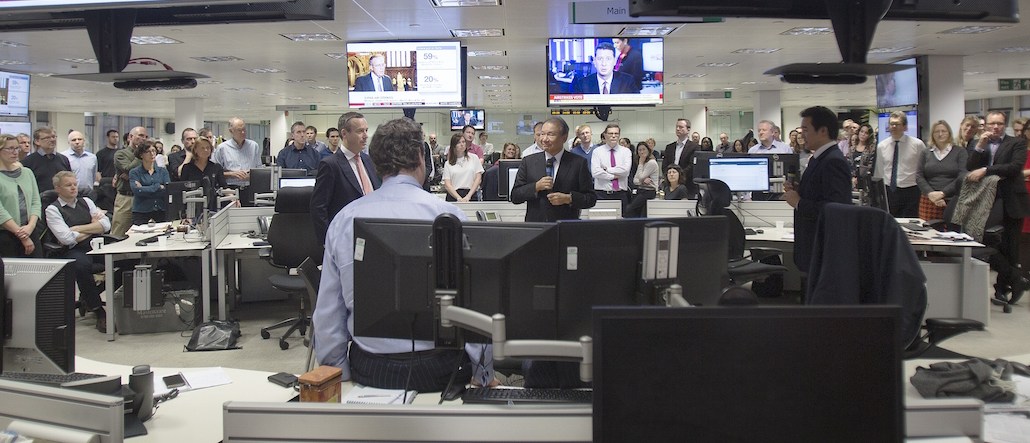How the FT plans to turn its content studio into a full-service agency

The Financial Times has big plans for expanding its content studio into a full-service agency.
Until now, it’s been adept at the delivery and distribution side of branded content, but not creative production. That’s all set to change with last month’s acquisition of content-marketing video specialist Alpha Grid. And, naturally for a paywalled publisher, much of the way forward lies in unlocking more subscriber data to help tailor its content.
Jon Slade, who was promoted to the new role of chief commercial officer two months ago, said cultivating the advertising department into a full-service agency and consultancy is a top priority. “We’re not just a vendor of pink or white space,” he told Digiday, referring to the newspaper’s signature salmon color.
“The advertising industry as a whole is bifurcating, and the vacated middle ground is direct-sold, hand-trafficked, CPM-bought inventory,” he said. “Instead, everyone is moving toward high-touch, rich, deep content solutions at one end, and audience automation, programmatic, hard-core media, at the other end. “The two can work together nicely, but we need to take our ad business away from the middle ground of ‘how many impressions do you want to buy?’”
The FT established its content-marketing operation, called FT Squared, last September. It launched a suite of new “paid posts” and “smart match” formats, which clients including BP and Santander have run with. It ran a series of articles for BP including: “Changes in the World of Energy” and “Why Scientists Give Science a Bad Name” to promote the brand’s “Committed to the U.K.” campaign. Readers have spend a total 230,000 hours with this content, according to the publisher.
Since then, the FT has grown branded-content revenues by 30 percent, accounting for 10 percent of all digital ad revenue, though Slade declined to give the raw numbers. In May, it appointed former FT tech and media editor Ravi Mattu as editorial director of FT Squared.
The addition of Alpha Grid will fill the “gap in its arsenal”: the ability to create better branded content on behalf of clients, according to Slade. Alpha Grid specializes in creating content aimed at global business decision-makers: the FT’s core demographic.
Alpha Grid staff will hot desk at the FT, though once the publisher moves back to its original headquarters at Bracken House near St Paul’s Cathedral, it will free up space for semi-permanent staffers. In total, 14 people now work on FT Squared.
Using subscription data for ad retargeting has been bread and butter at the FT for a while, but it has yet to drill into it to help shape and inform the creation of branded content and help brand partners make decisions around their own content-marketing strategies and media planning.
“The data we yield from the analytics that powers our subscription business is as applicable for own subscription business as it is to our own clients’ ad businesses. My job is to pull all those threads together into a coherent offering for our clients,” he added.
The FT uses advanced analytics systems to power its newsroom and its subscriptions business. It has already had success using real-time editorial data to drive its own subscription marketing plans; now it can apply the same techniques for clients.
“We understand what motivates a reader, what draws them to a piece of content, and deeper thoughts on their media consumption,” said Slade. “We can tell a client what the lead stories are, if it’s something around Brexit, for example, and we can tell them what people are reading and when, how much of it each reads, and what the optimum length of video or text article their content should be.”
The end goal is to have advertisers regard FT.com as a marketing platform, not a place to buy space, which requires scale. “I don’t think scale is something news sites can ever win at,” he added.
It may have its work cut out for it. Charlotte Tice, head of publishing at Mindshare, said publishers can’t afford not to expand their content-marketing offers and that the FT’s subscriber data pot is “gold” and will therefore always attract certain clients. However, though branded content opens up larger budgets than typical display campaigns, they’re harder to get signed off, and there are a swarm of other traditional and non-traditional rivals pitching for the same briefs.
“You could have Google, the FT, Global Radio and JC Decaux, for example, all up for the same pitch, because in branded content, everyone is a competitor,” she said. “It’s a significant investment. There’s, of course, potentially a big pay-off, but if you do a load and they don’t get signed off, that’s very costly.”
Image: courtesy of the FT.
More in Media

YouTube is under fire again, this time over child protection
Adalytics Research asks, ‘Are YouTube advertisers inadvertently harvesting data from millions of children?’

Media Briefing: Publishers pump up per-subscriber revenue amid ad revenue declines
Publishers’ Q2 earnings reveal digital advertising is still in a tight spot, but digital subscriptions are picking up steam.

Lessons for AI from the ad-tech era: ‘We’re living in a memory-less world’
Experts reflect how the failures of social media and online advertising can help the industry improve the next era of innovation.
Ad position: web_bfu